Spatiotemporal Analysis and Anomalous Trends of Asia AOD (2001–2024): Insights from a Deep Learning Fusion Model and EOF Decomposition
Abstract
1. Introduction
2. Materials and Methods
2.1. Study Region
2.2. Datasets
2.2.1. Satellite AOD Product
2.2.2. Atmospheric Reanalysis AOD
2.2.3. Meteorological Fields
2.2.4. Additional Data
2.2.5. Data Reprocessing
2.3. The Framework of This Study
2.3.1. AOD Fusion Model
2.3.2. Empirical Orthogonal Function Analysis
2.4. AOD Fusion Model Performance Evaluation
3. Results
3.1. AOD Fusion Model Performance
3.2. Spatiotemporal Distribution of Asia AOD
4. Discussion
4.1. Long-Term Trends of Asia AOD
4.2. Anomalous Trends of Asia AOD
5. Conclusions
Author Contributions
Funding
Data Availability Statement
Acknowledgments
Conflicts of Interest
Abbreviations
| AOD | Aerosol Optical Depth |
| EOF | Empirical Orthogonal Function |
| MODIS | Moderate Resolution Imaging Spectroradiometer |
| MAIAC | Multi-Angle Implementation of Atmospheric Correction |
| MERRA-2 | Modern-Era Retrospective analysis for Research and Applications, Version 2 |
| ECMWF | European Centre for Medium-Range Weather Forecasts |
| SRTM | Shuttle Radar Topography Mission |
| DEM | Digital Elevation Model |
| AERONET | AErosol RObotic NETwork |
| PCs | principal components |
| R2 | coefficient of determination |
| RMSE | root mean square error |
Appendix A
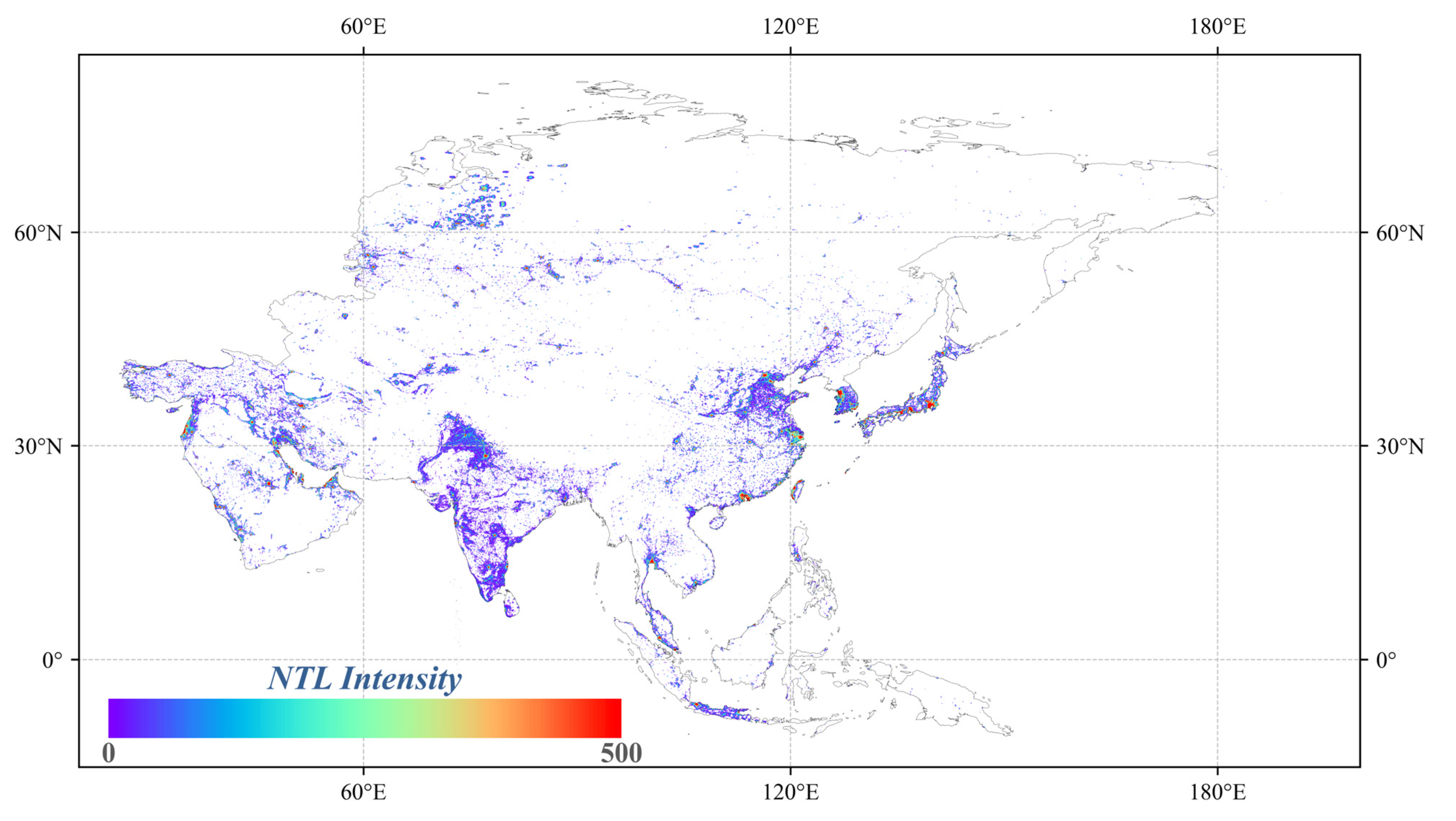
References
- Li, X.; Zhang, C.; Li, W.; Anyah, R.O.; Jing, T. Exploring the Trend, Prediction and Driving Forces of Aerosols Using Satellite and Ground Data, and Implications for Climate Change Mitigation. J. Clean. Prod. 2019, 223, 238–251. [Google Scholar] [CrossRef]
- Yang, Z.; Zdanski, C.; Farkas, D.; Bang, J.; Harris, W. Evaluation of Aerosol Optical Depth (Aod) and Pm2.5 Associations for Air Quality Assessment. Remote Sens. Appl. Soc. Environ. 2020, 20, 100396. [Google Scholar] [CrossRef]
- Cirino, G.G.; Souza, R.A.F.; Adams, D.K.; Artaxo, P. The Effect of Atmospheric Aerosol Particles and Clouds on Net Ecosystem Exchange in the Amazon. Atmos. Chem. Phys. 2014, 14, 6523–6543. [Google Scholar] [CrossRef]
- Kim, D.; Kim, J.; Jeong, J.; Choi, M. Estimation of Health Benefits from Air Quality Improvement Using the Modis Aod Dataset in Seoul, Korea. Environ. Res. 2019, 173, 452–461. [Google Scholar] [CrossRef]
- Kaufman, Y.J. Aerosol Optical Thickness and Atmospheric Path Radiance. J. Geophys. Res. Atmos. 1993, 98, 2677–2692. [Google Scholar] [CrossRef]
- Kant, Y.; Ghosh, A.B.; Sharma, M.C.; Gupta, P.K.; Prasad, V.K.; Badarinath, K.V.S.; Mitra, A.P. Studies on Aerosol Optical Depth in Biomass Burning Areas Using Satellite and Ground-Based Observations. Infrared Phys. Technol. 2000, 41, 21–28. [Google Scholar] [CrossRef]
- Eck, T.F.; Holben, B.N.; Reid, J.S.; Dubovik, O.; Smirnov, A.; O’Neill, N.T.; Slutsker, I.; Kinne, S. Wavelength Dependence of the Optical Depth of Biomass Burning, Urban, and Desert Dust Aerosols. J. Geophys. Res. Atmos. 1999, 104, 31333–31349. [Google Scholar]
- Streets, D.G.; Yan, F.; Chin, M.; Diehl, T.; Mahowald, N.; Schultz, M.; Wild, M.; Wu, Y.; Yu, C. Anthropogenic and Natural Contributions to Regional Trends in Aerosol Optical Depth, 1980–2006. J. Geophys. Res. Atmos. 2009, 114, D00D18. [Google Scholar] [CrossRef]
- Wei, X.; Chang, N.-B.; Bai, K.; Gao, W. Satellite Remote Sensing of Aerosol Optical Depth: Advances, Challenges, and Perspectives. Crit. Rev. Environ. Sci. Technol. 2020, 50, 1640–1725. [Google Scholar] [CrossRef]
- Padimala, S.S.K.; Matli, C.S. A Comprehensive Review Delineates Advancements in Retrieving Particulate Matter Utilising Satellite Aerosol Optical Depth: Parameter Consideration, Data Processing, Models Development and Future Perspectives. Atmos. Res. 2024, 308, 107514. [Google Scholar] [CrossRef]
- Sogacheva, L.; Popp, T.; Sayer, A.M.; Dubovik, O.; Garay, M.J.; Heckel, A.; Hsu, N.C.; Jethva, H.; Kahn, R.A.; Kolmonen, P.; et al. Merging Regional and Global Aerosol Optical Depth Records from Major Available Satellite Products. Atmos. Chem. Phys. 2020, 20, 2031–2056. [Google Scholar] [CrossRef]
- Lyapustin, A.; Wang, Y.; Korkin, S.; Huang, D. Modis Collection 6 Maiac Algorithm. Atmos. Meas. Tech. 2018, 11, 5741–5765. [Google Scholar] [CrossRef]
- Qin, W.; Fang, H.; Wang, L.; Wei, J.; Zhang, M.; Su, X.; Bilal, M.; Liang, X. Modis High-Resolution Maiac Aerosol Product: Global Validation and Analysis. Atmos. Environ. 2021, 264, 118684. [Google Scholar] [CrossRef]
- Yang, J.; Hu, M. Filling the Missing Data Gaps of Daily Modis Aod Using Spatiotemporal Interpolation. Sci. Total Environ. 2018, 633, 677–683. [Google Scholar] [CrossRef]
- Zhang, T.; Zhou, Y.; Zhao, K.; Zhu, Z.; Asrar, G.R.; Zhao, X. Gap-Filling Modis Daily Aerosol Optical Depth Products by Developing a Spatiotemporal Fitting Algorithm. GIScience Remote Sens. 2022, 59, 762–781. [Google Scholar] [CrossRef]
- Katoch, V.; Kumar, A.; Imam, F.; Sarkar, D.; Knibbs, L.D.; Liu, Y.; Ganguly, D.; Dey, S. Addressing Biases in Ambient Pm2.5 Exposure and Associated Health Burden Estimates by Filling Satellite Aod Retrieval Gaps over India. Environ. Sci. Technol. 2023, 57, 19190–19201. [Google Scholar] [CrossRef] [PubMed]
- Kyunghwa, L.; Mijeong, K.; Myungje, C.; Jhoon, K.; Yunsoo, C.; Jaehoon, J.; Kyung-Jung, M.; Sojin, L. Fast and Operational Gap Filling in Satellite-Derived Aerosol Optical Depths Using Statistical Techniques. J. Appl. Remote Sens. 2022, 16, 044507. [Google Scholar]
- Singh, M.K.; Venkatachalam, P.; Gautam, R. Geostatistical Methods for Filling Gaps in Level-3 Monthly-Mean Aerosol Optical Depth Data from Multi-Angle Imaging Spectroradiometer. Aerosol Air Qual. Res. 2017, 17, 1963–1974. [Google Scholar] [CrossRef]
- Zhao, C.; Liu, Z.; Wang, Q.; Ban, J.; Chen, N.X.; Li, T. High-Resolution Daily Aod Estimated to Full Coverage Using the Random Forest Model Approach in the Beijing-Tianjin-Hebei Region. Atmos. Environ. 2019, 203, 70–78. [Google Scholar] [CrossRef]
- Li, X.; Liu, K.; Tian, J. Variability, Predictability, and Uncertainty in Global Aerosols Inferred from Gap-Filled Satellite Observations and an Econometric Modeling Approach. Remote Sens. Environ. 2021, 261, 112501. [Google Scholar] [CrossRef]
- Chen, Z.-Y.; Jin, J.-Q.; Zhang, R.; Zhang, T.-H.; Chen, J.-J.; Yang, J.; Ou, C.-Q.; Guo, Y. Comparison of Different Missing-Imputation Methods for Maiac (Multiangle Implementation of Atmospheric Correction) Aod in Estimating Daily Pm2.5 Levels. Remote Sens. 2020, 12, 3008. [Google Scholar] [CrossRef]
- Liang, T.; Liang, S.; Zou, L.; Sun, L.; Li, B.; Lin, H.; He, T.; Tian, F. Estimation of Aerosol Optical Depth at 30 M Resolution Using Landsat Imagery and Machine Learning. Remote Sens. 2022, 14, 1053. [Google Scholar] [CrossRef]
- Malarvizhi, A.S.; Pan, P. Multi-Source Data Fusion for Filling Gaps in Satellite Aerosol Optical Depth (Aod) Using Generative Models. In Proceedings of the 3rd ACM SIGSPATIAL International Workshop on Spatial Big Data and AI for Industrial Applications, Atlanta, GA, USA, 29 October–1 November 2024; Association for Computing Machinery: New York, NY, USA, 2024; pp. 28–38. [Google Scholar]
- Han, M.; Jia, S.; Zhang, C. Estimation of High-Resolution Pm2.5 Concentrations Based on Gap-Filling Aerosol Optical Depth Using Gradient Boosting Model. Air Qual. Atmos. Health 2022, 15, 619–631. [Google Scholar] [CrossRef]
- Li, L.; Franklin, M.; Girguis, M.; Lurmann, F.; Wu, J.; Pavlovic, N.; Breton, C.; Gilliland, F.; Habre, R. Spatiotemporal Imputation of Maiac Aod Using Deep Learning with Downscaling. Remote Sens. Environ. 2020, 237, 111584. [Google Scholar] [CrossRef]
- Liu, N.; Li, Y.; Zang, Z.; Hu, Y.; Fang, X.; Lolli, S. A Deep Learning-Based Imputation Method for Missing Gaps in Satellite Aerosol Products by Fusing Numerical Model Data. Atmos. Environ. 2024, 325, 120440. [Google Scholar] [CrossRef]
- Daniels, J.; Bailey, C.P.; Liang, L. Filling Cloud Gaps in Satellite Aod Retrievals Using an Lstm Cnn-Autoencoder Model. Presented at the IGARSS 2022–2022 IEEE International Geoscience and Remote Sensing Symposium, Kuala Lumpur, Malaysia, 17–22 July 2022. [Google Scholar]
- Liu, S.; Zhang, L. Deep Feature Gaussian Processes for Single-Scene Aerosol Optical Depth Reconstruction. IEEE Geosci. Remote Sens. Lett. 2024, 21, 5505705. [Google Scholar] [CrossRef]
- Wang, S.; Hao, J. Air Quality Management in China: Issues, Challenges, and Options. J. Environ. Sci. 2012, 24, 2–13. [Google Scholar] [CrossRef]
- Bi, S.; Hu, J.; Shao, L.; Feng, T.; Appolloni, A. Can Public Transportation Development Improve Urban Air Quality? Evidence from China. Urban Clim. 2024, 54, 101825. [Google Scholar] [CrossRef]
- Wen, Z.; Ma, X.; Xu, W.; Si, R.; Liu, L.; Ma, M.; Zhao, Y.; Tang, A.; Zhang, Y.; Wang, K.; et al. Combined Short-Term and Long-Term Emission Controls Improve Air Quality Sustainably in China. Nat. Commun. 2024, 15, 5169. [Google Scholar] [CrossRef]
- Liu, H.; Yu, Y.; Xia, D.; Zhao, S.; Ma, X.; Dong, L. Analysis of the Relationship between Dust Aerosol and Precipitation in Spring over East Asia Using Eof and Svd Methods. Sci. Total Environ. 2024, 908, 168437. [Google Scholar] [CrossRef]
- Shao, Z.; Wang, H.; Geng, Y.-F.; Diao, C.; Xu, Y.; Zheng, X.-T. East Asian Summer Monsoon Response to Anthropogenic Aerosols Redistribution: Contrasting 1950–1980 and 1980–2010 to Understand the Role of Non-Asian Forcing. Clim. Dyn. 2024, 62, 2187–2205. [Google Scholar] [CrossRef]
- Khoir, A.N.; Ooi, M.C.G.; Juneng, L.; Ramadhan, M.A.I.; Virgianto, R.H.; Tangang, F. Spatio-Temporal Analysis of Aerosol Optical Depth Using Rotated Empirical Orthogonal Function over the Maritime Continent from 2001 to 2020. Atmos. Environ. 2022, 290, 119356. [Google Scholar] [CrossRef]
- Irfan, H. Air Pollution and Cardiovascular Health in South Asia: A Comprehensive Review. Curr. Probl. Cardiol. 2024, 49, 102199. [Google Scholar] [CrossRef] [PubMed]
- Shindell, D.; Faluvegi, G.; Nagamoto, E.; Parsons, L.; Zhang, Y. Reductions in Premature Deaths from Heat and Particulate Matter Air Pollution in South Asia, China, and the United States under Decarbonization. Proc. Natl. Acad. Sci. USA 2024, 121, e2312832120. [Google Scholar] [CrossRef]
- Huang, G.; Su, X.; Wang, L.; Wang, Y.; Cao, M.; Wang, L.; Ma, X.; Zhao, Y.; Yang, L. Evaluation and Analysis of Long-Term Modis Maiac Aerosol Products in China. Sci. Total Environ. 2024, 948, 174983. [Google Scholar] [CrossRef]
- Ji, W.; Yang, L.; Tian, X.; Bilal, M.; Pei, X.; Zheng, Y.; Lu, X.; Cheng, X. Long-Term Validation and Error Analysis of Db and Maiac Aerosol Products over Bright Surface of China. Atmos. Res. 2024, 297, 107106. [Google Scholar] [CrossRef]
- Ansari, K.; Ramachandran, S. Optical and Physical Characteristics of Aerosols over Asia: Aeronet, Merra-2 and Cams. Atmos. Environ. 2024, 326, 120470. [Google Scholar] [CrossRef]
- Soci, C.; Hersbach, H.; Simmons, A.; Poli, P.; Bell, B.; Berrisford, P.; Horányi, A.; Muñoz-Sabater, J.; Nicolas, J.; Radu, R.; et al. The Era5 Global Reanalysis from 1940 to 2022. Q. J. R. Meteorol. Soc. 2024, 150, 4014–4048. [Google Scholar] [CrossRef]
- Yang, L.; Meng, X.; Zhang, X. Srtm Dem and Its Application Advances. Int. J. Remote Sens. 2011, 32, 3875–3896. [Google Scholar] [CrossRef]
- Andrews, E.; Ogren, J.A.; Kinne, S.; Samset, B. Comparison of Aod, Aaod and Column Single Scattering Albedo from Aeronet Retrievals and in Situ Profiling Measurements. Atmos. Chem. Phys. 2017, 17, 6041–6072. [Google Scholar] [CrossRef]
- Giles, D.M.; Holben, B.N.; Eck, T.F.; Sinyuk, A.; Smirnov, A.; Slutsker, I.; Dickerson, R.R.; Thompson, A.M.; Schafer, J.S. An Analysis of Aeronet Aerosol Absorption Properties and Classifications Representative of Aerosol Source Regions. J. Geophys. Res. Atmos. 2012, 117, D17203. [Google Scholar] [CrossRef]
- Ni, W.; Ding, Y.; Li, S.; Teng, M.; Yang, J. Estimation of Daily Seamless Pm2.5 Concentrations with Climate Feature in Hubei Province, China. Remote Sens. 2023, 15, 3822. [Google Scholar] [CrossRef]
- Arik, S.Ö.; Pfister, T. Tabnet: Attentive Interpretable Tabular Learning. Proc. AAAI Conf. Artif. Intell. 2021, 35, 6679–6687. [Google Scholar] [CrossRef]
- Dong, X.; Li, R.; Wang, Y.; Fu, Y.; Zhao, C. Potential Impacts of Sahara Dust Aerosol on Rainfall Vertical Structure over the Atlantic Ocean as Identified from Eof Analysis. J. Geophys. Res. Atmos. 2018, 123, 8850–8868. [Google Scholar] [CrossRef]
- Bao, C.; Yang, Y.; Bagan, H.; Wang, Q.; Te, T.; Uudus, B.; Yong, M.; Liao, T. Dust Intensity across Vegetation Types in Mongolia: Drivers and Trends. Remote Sens. 2025, 17, 410. [Google Scholar] [CrossRef]
- Borjigin, A.; Bueh, C.; Yong, M.; Purevjav, G.; Xie, Z. Cross-Border Sand and Dust Storms between Mongolia and Northern China in Spring and Their Driving Weather Systems. Remote Sens. 2024, 16, 2164. [Google Scholar] [CrossRef]
- Xue, Y.-B.; Zhang, X.-X.; Lei, J.-Q.; Li, S.-Y.; Liu, L.-Y.; Wang, Z.-F.; Tian, W.-J.; Tang, X.; Chen, X.-S. East Asian Dust Storm in March 2021: Perspective Views from Ground Observation, Satellite Measurement and Numerical Simulation. Atmos. Environ. 2025, 350, 121152. [Google Scholar] [CrossRef]
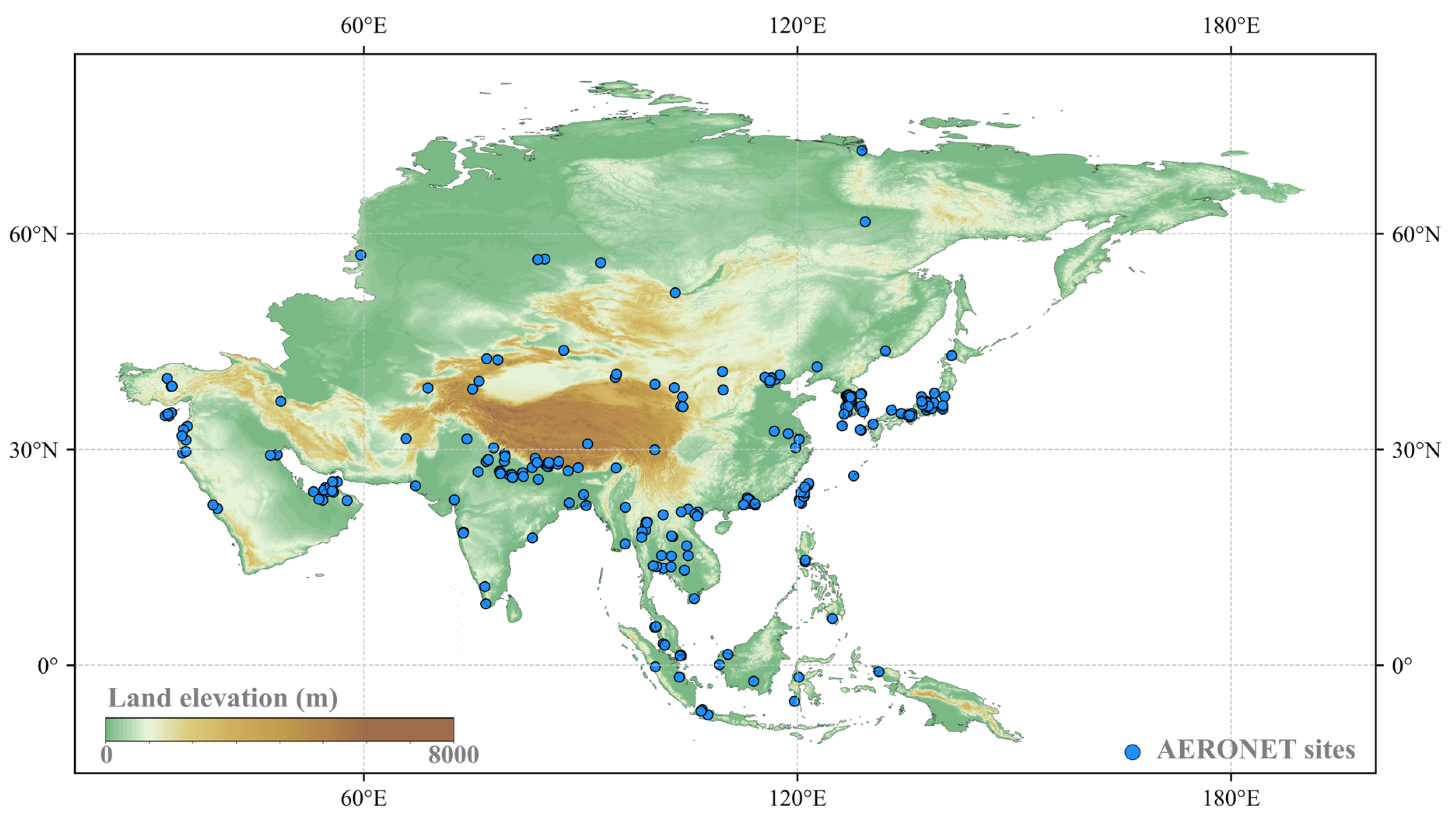

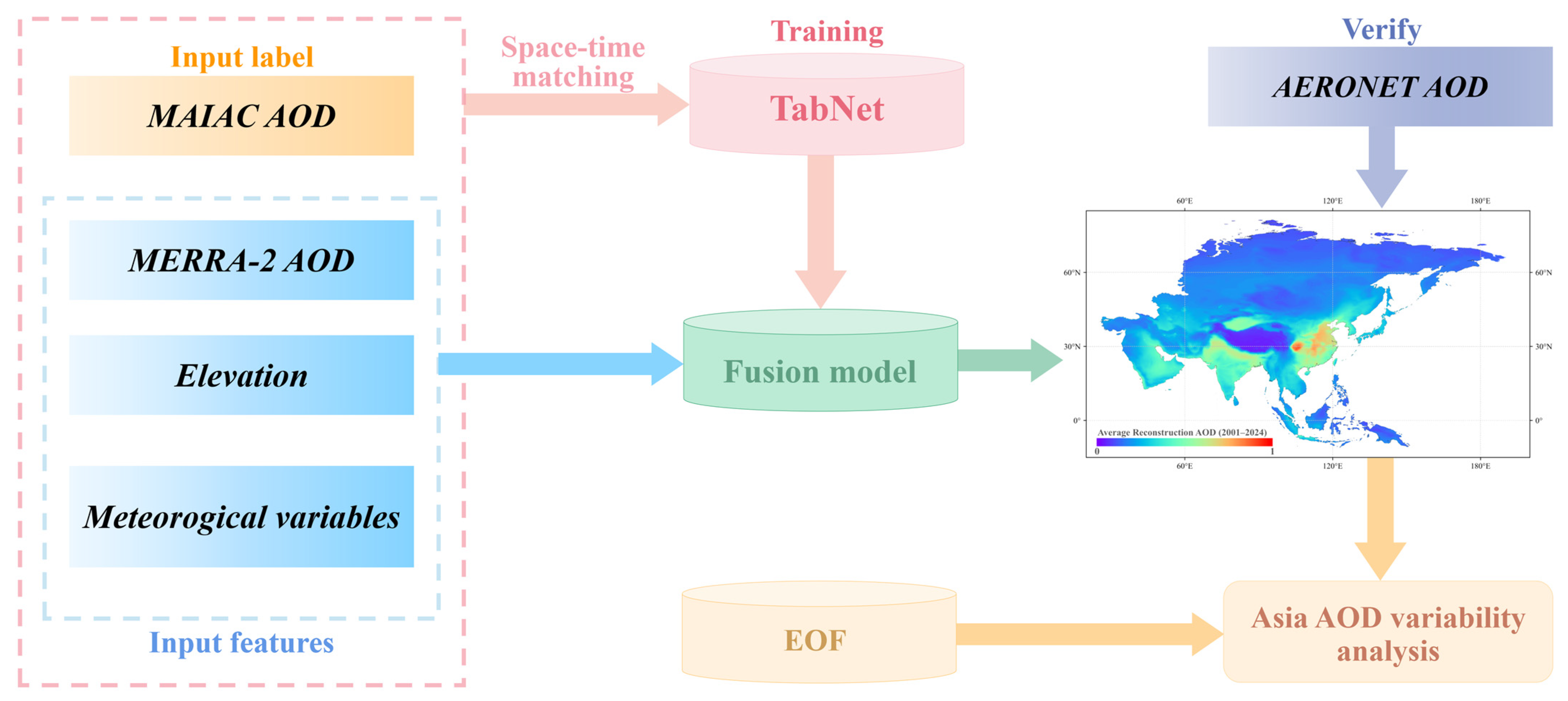
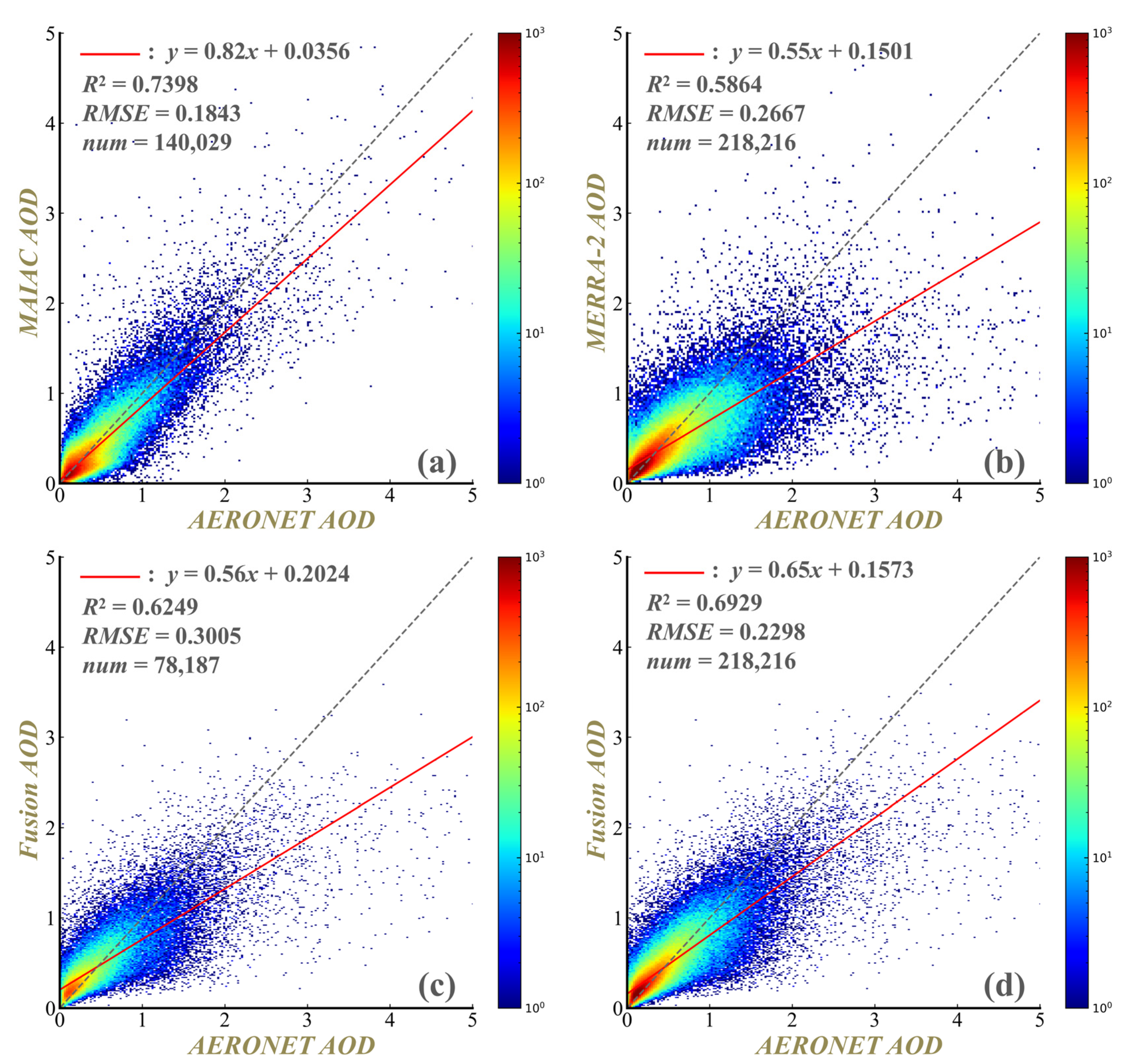
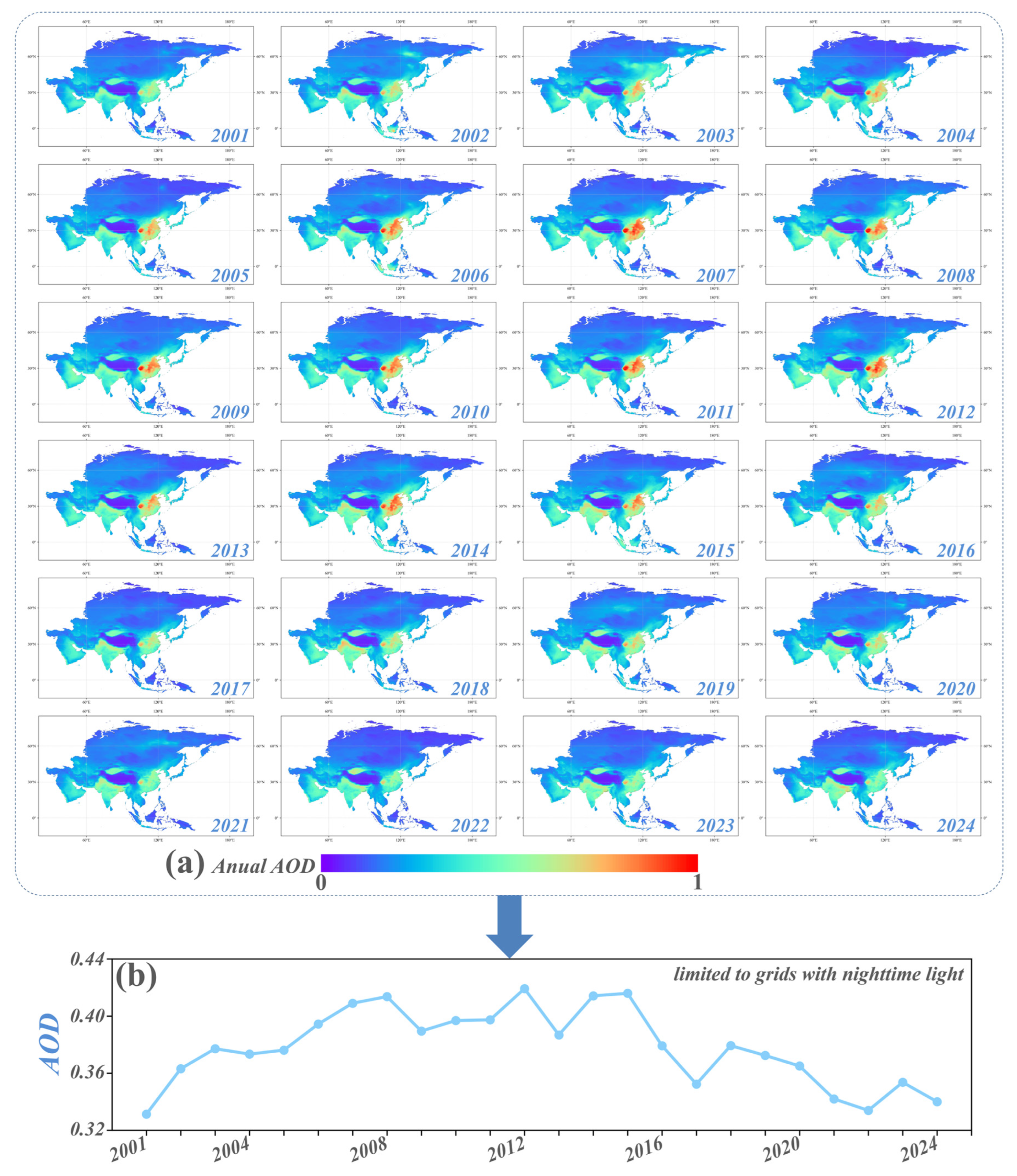

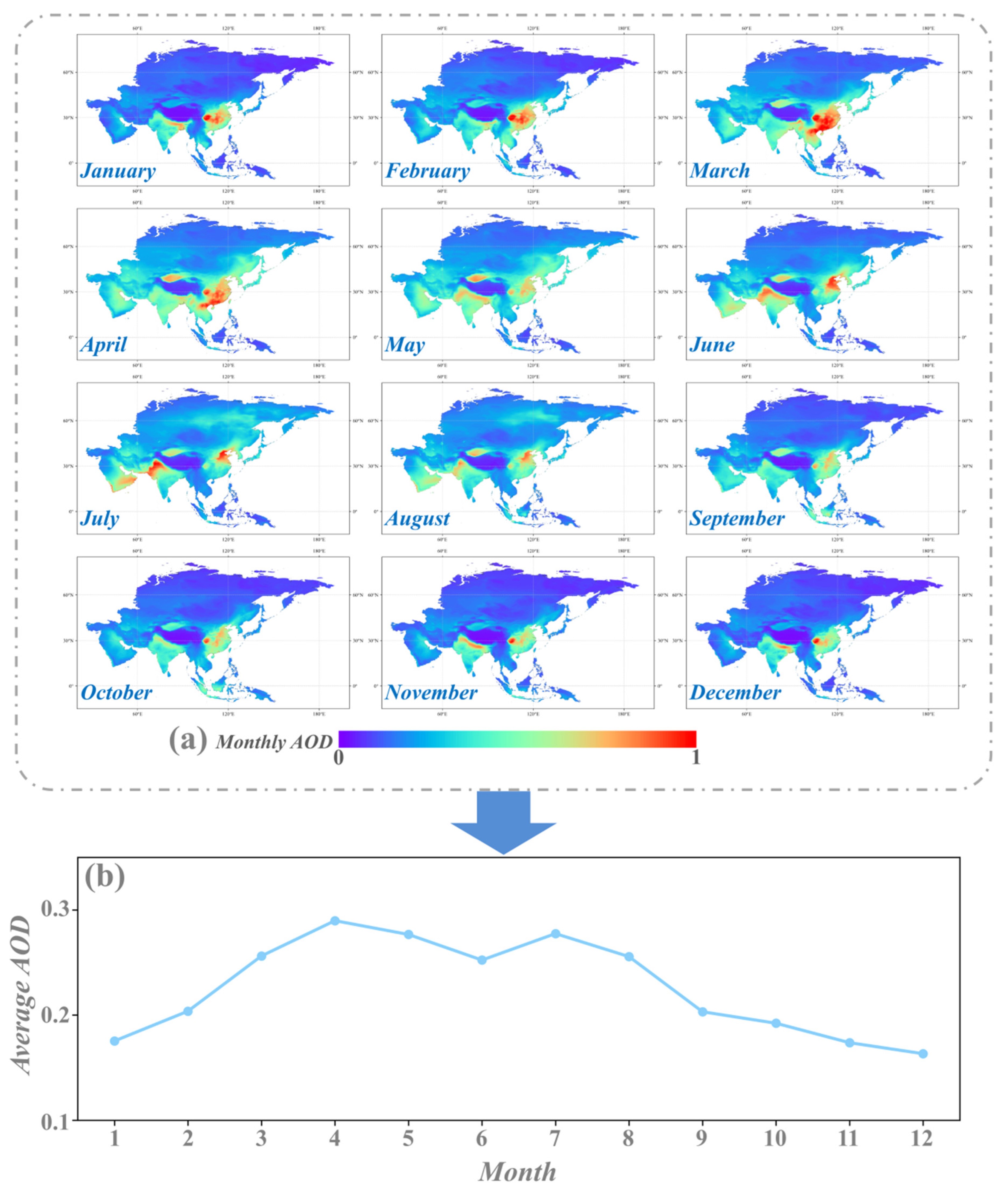
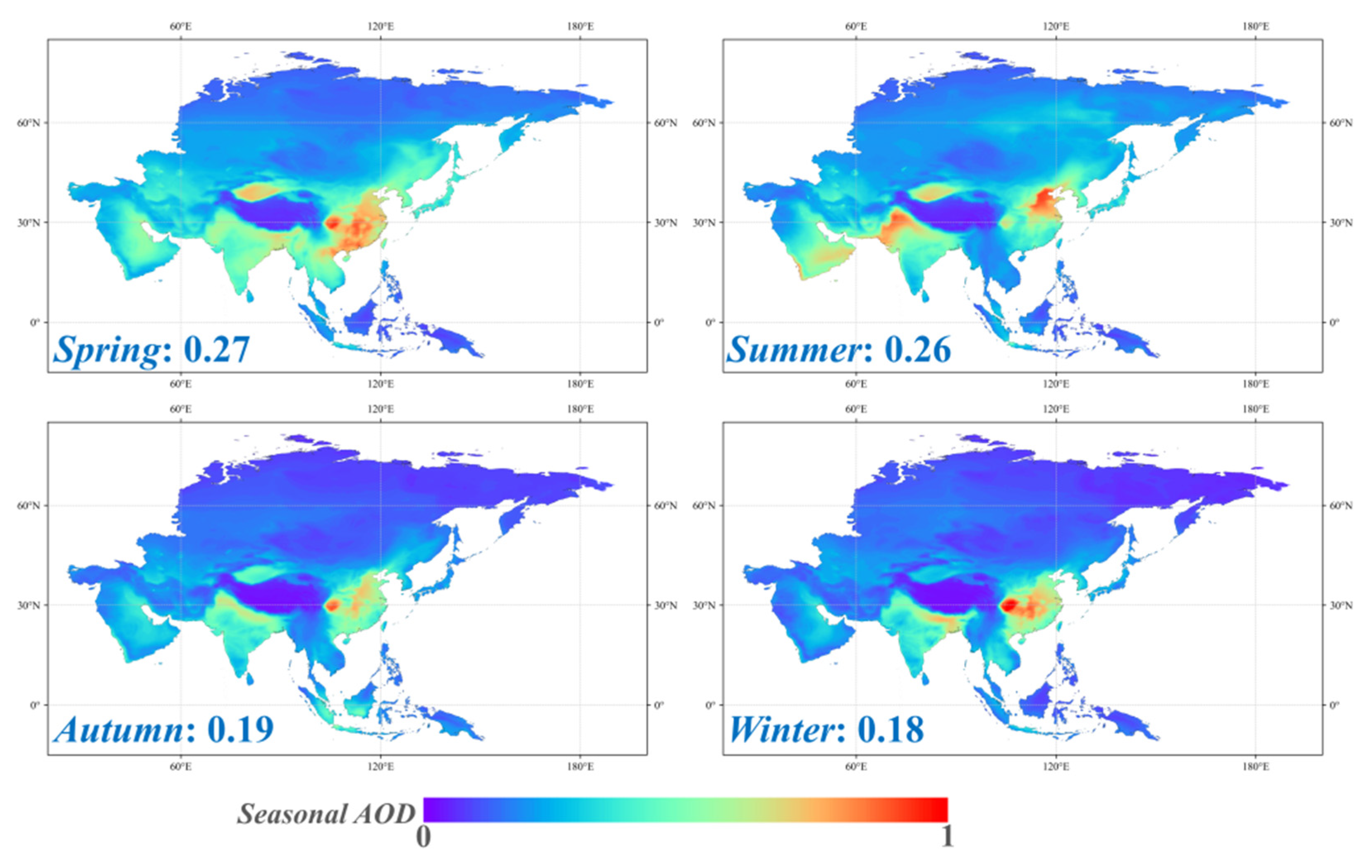
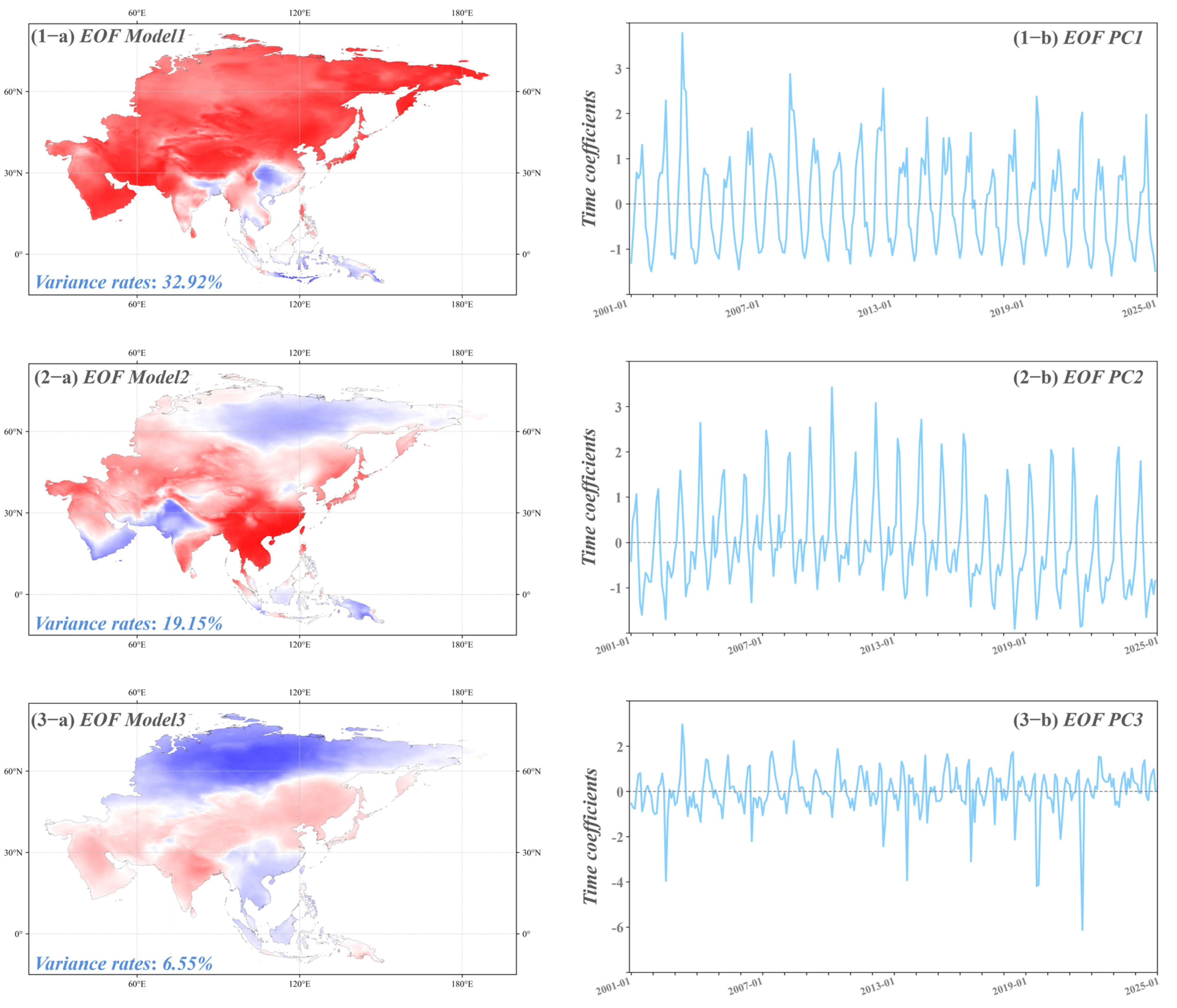
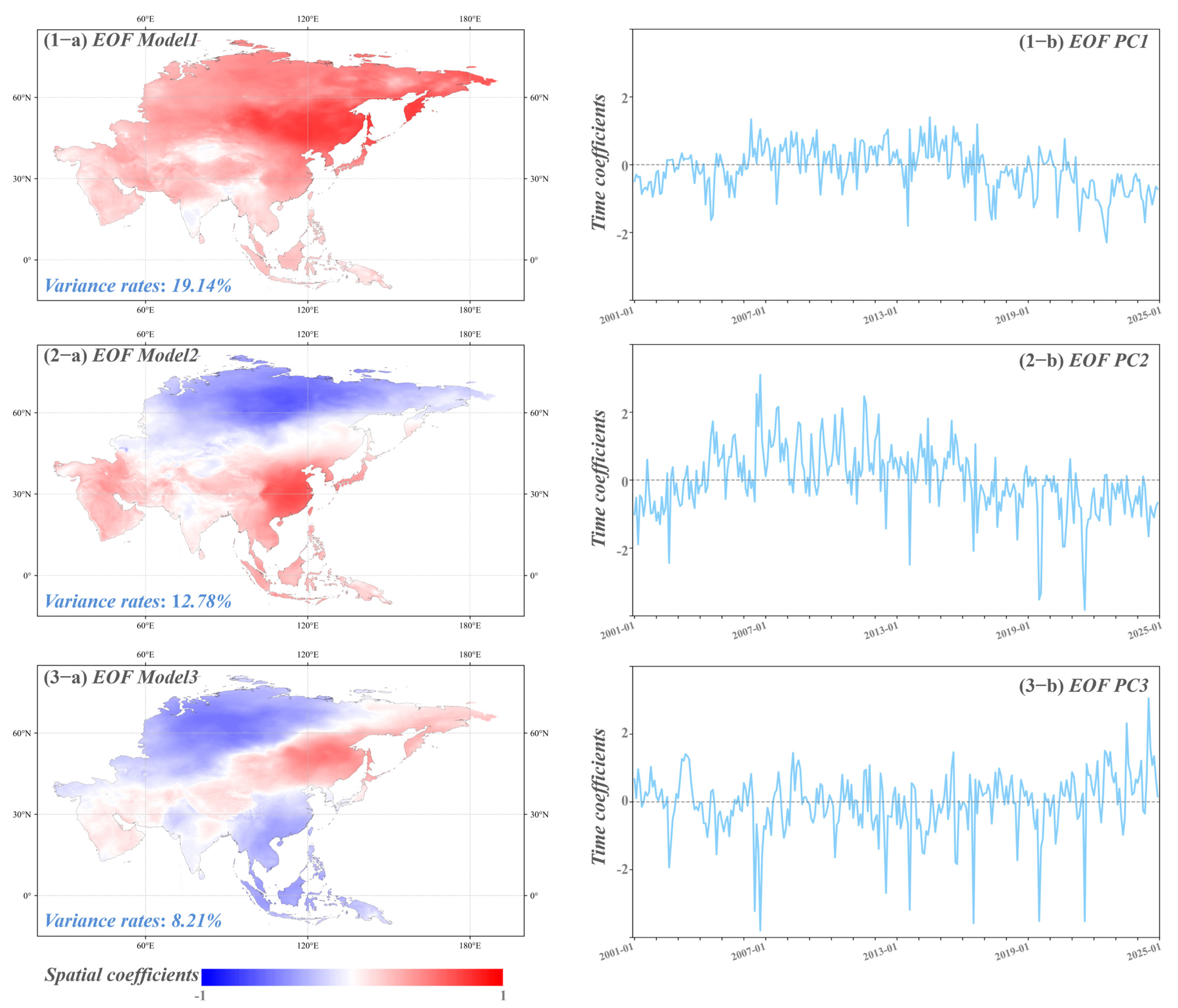
Disclaimer/Publisher’s Note: The statements, opinions and data contained in all publications are solely those of the individual author(s) and contributor(s) and not of MDPI and/or the editor(s). MDPI and/or the editor(s) disclaim responsibility for any injury to people or property resulting from any ideas, methods, instructions or products referred to in the content. |
© 2025 by the authors. Licensee MDPI, Basel, Switzerland. This article is an open access article distributed under the terms and conditions of the Creative Commons Attribution (CC BY) license (https://creativecommons.org/licenses/by/4.0/).
Share and Cite
Ding, Y.; Ni, W.; Dong, J.; Yang, J.; Meng, S.; Li, S. Spatiotemporal Analysis and Anomalous Trends of Asia AOD (2001–2024): Insights from a Deep Learning Fusion Model and EOF Decomposition. Remote Sens. 2025, 17, 1741. https://doi.org/10.3390/rs17101741
Ding Y, Ni W, Dong J, Yang J, Meng S, Li S. Spatiotemporal Analysis and Anomalous Trends of Asia AOD (2001–2024): Insights from a Deep Learning Fusion Model and EOF Decomposition. Remote Sensing. 2025; 17(10):1741. https://doi.org/10.3390/rs17101741
Chicago/Turabian StyleDing, Yu, Wenjia Ni, Jiaxin Dong, Jie Yang, Shiyao Meng, and Siwei Li. 2025. "Spatiotemporal Analysis and Anomalous Trends of Asia AOD (2001–2024): Insights from a Deep Learning Fusion Model and EOF Decomposition" Remote Sensing 17, no. 10: 1741. https://doi.org/10.3390/rs17101741
APA StyleDing, Y., Ni, W., Dong, J., Yang, J., Meng, S., & Li, S. (2025). Spatiotemporal Analysis and Anomalous Trends of Asia AOD (2001–2024): Insights from a Deep Learning Fusion Model and EOF Decomposition. Remote Sensing, 17(10), 1741. https://doi.org/10.3390/rs17101741







